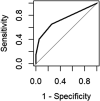Psychometric properties of the dissociative subtype of posttraumatic stress disorder scale: replication and extension in two German-speaking samples
- PMID: 37593980
- PMCID: PMC10443992
- DOI: 10.1080/20008066.2023.2238492
Psychometric properties of the dissociative subtype of posttraumatic stress disorder scale: replication and extension in two German-speaking samples
Abstract
Background: The fifth version of the Diagnostic and Statistical Manual of Mental Disorders (DSM-5) introduced the dissociative subtype of posttraumatic stress disorder (D-PTSD). To assess this subtype, the Dissociative Subtype of PTSD Scale (DSPS), a 15-item self-report measure to identify lifetime and current dissociative symptoms of D-PTSD, was developed. However, so far, the scale has only been validated in war veterans. Moreover, criterion validity and diagnostic utility have not been examined yet.Objective: We aimed to validate the DSPS in two samples of civilian trauma-exposed German-speaking participants.Methods: In Study 1, a pre-registered online study, participants with and without PTSD symptoms (N = 558) answered questionnaires about traumatic experiences, dissociation, PTSD, depression, generalized anxiety disorder, somatic symptom disorder, alcohol use disorder, absorption, and dissociative responding to trauma-related questionnaires. In Study 2, which used secondary data of a pre-registered clinical study, participants with a PTSD diagnosis (N = 71) answered questionnaires about traumatic experiences, dissociation, PTSD, depression, generalized anxiety disorder, somatic symptom disorder, and dissociative responding to standardized trauma exposure. Moreover, PTSD, D-PTSD, and other diagnoses were assessed with structured clinical interviews.Results: Analyses confirmed a three-factor structure as well as high internal consistency, and high convergent, discriminant, and criterion validity of the DSPS. Moreover, the scale was able to identify a latent D-PTSD group and individuals with D-PTSD diagnosis.Conclusions: The DSPS constitutes a reliable and valid tool to assess D-PTSD symptoms in clinical practice and research and thereby may contribute to a better understanding of these debilitating symptoms.
Antecedentes: La quinta versión del Manual Diagnóstico y Estadístico de los Trastornos Mentales (DSM-5) introdujo el subtipo disociativo del trastorno de estrés postraumático (TEPT-D). Para evaluar este subtipo, Wolf et al. (2017) desarrollaron la Escala del Subtipo Disociativo del TEPT (DSPS por sus siglas en ingles), una medida de autoinforme de 15 ítems para identificar los síntomas disociativos vitales y actuales del TEPT-D. Sin embargo, hasta ahora, la escala solo se ha validado en veteranos de guerra. Además, aún no se ha examinado la validez de criterio ni la utilidad diagnóstica.
Objetivo: Nuestro objetivo era validar la DSPS en dos muestras de participantes civiles de habla alemana expuestos a traumas.
Métodos: En el Estudio 1, un estudio online registrado previamente, los participantes con y sin síntomas de TEPT (N = 558) respondieron a cuestionarios sobre experiencias traumáticas, disociación, TEPT, depresión, trastorno de ansiedad generalizada, trastorno por síntomas somáticos, trastorno por consumo de alcohol, absorción y respuesta disociativa a cuestionarios relacionados con el trauma. En el Estudio 2, que utilizó datos secundarios de un estudio clínico registrado previamente, los participantes con diagnóstico de TEPT (N = 71) respondieron a cuestionarios sobre experiencias traumáticas, disociación, TEPT, depresión, trastorno de ansiedad generalizada, trastorno de síntomas somáticos y respuesta disociativa a la exposición estandarizada al trauma. Además, se evaluaron el TEPT, el TEPT-D y otros diagnósticos mediante entrevistas clínicas estructuradas.
Resultados: Los análisis confirmaron una estructura trifactorial, así como una elevada consistencia interna y una alta validez convergente, discriminante y de criterio de la DSPS. Además, la escala fue capaz de identificar un grupo latente de TEPT-D e individuos con diagnóstico de TEPT-D.
Conclusiones: La DSPS constituye una herramienta fiable y válida para evaluar los síntomas del D-PTSD en la práctica clínica y la investigación y, por lo tanto, puede contribuir a una mejor comprensión de estos síntomas debilitantes.
背景:第五版精神障碍诊断与统计手册(DSM-5)引入了创伤后应激障碍的解离亚型(D-PTSD)。为了评估这种亚型,Wolf 等人 (2017) 开发了 PTSD 解离亚型量表 (DSPS),一个包含 15个条目的自我报告测量,用于识别 D-PTSD 终身和当前的解离症状。然而,到目前为止,该量表仅在退伍军人中得到验证。 此外,标准效度和诊断实用性尚未得到检验。
目的:我们旨在于两个创伤暴露的德语普通参与者样本中验证 DSPS。
方法:在研究 1(一项预注册的在线研究)中,有或没有 PTSD 症状的参与者 (N = 558) 回答了有关创伤经历、解离、PTSD、抑郁、广泛性焦虑障碍、躯体症状障碍、酒精使用障碍、吸收、以及对创伤相关问卷的分离反应。在研究 2 中,使用了预注册临床研究的二手数据,有 PTSD 诊断的参与者 (N = 71) 回答了关于创伤经历、解离、PTSD、抑郁、广泛性焦虑障碍、躯体症状障碍和对标准化创伤暴露的解离反应的问卷。此外,PTSD、D-PTSD 和其他诊断均通过结构化临床访谈进行评估。
结果:分析证实了 DSPS 的三因素结构以及高内部一致性、高收敛性、判别性和标准有效性。此外,该量表能够识别潜在 D-PTSD 群体和有 D-PTSD 诊断的个体。
结论:DSPS 构成了临床实践和研究中评估 D-PTSD 症状的可靠且有效的工具,从而可能有助于更好了解这些使人衰弱的症状。
Keywords: Albanian; Albanés; Alemán; Cuestionario; Disociación; Dissociation; Escala; Evaluación; German; Instrumento; Trastorno de estrés postraumático; Ucraniano; Ukrainian; Validación; assessment; instrument; posttraumatic stress disorder; questionnaire; scale; validation; 乌克兰语; 创伤后应激障碍; 工具; 德语; 解离; 评估; 量表; 问卷; 阿尔巴尼亚语; 验证.
Plain language summary
Many individuals with posttraumatic stress disorder (PTSD) suffer from dissociative symptoms which can be assessed with the Dissociative Subtype of PTSD Scale (DSPS; Wolf et al., 2017).The DSPS demonstrated good psychometric properties in two German-speaking trauma-exposed samples and hence might be used to assess D-PTSD symptoms in research and clinical practice.Complementing the original English version, a German version of the DSPS is provided in the Supplements.
Conflict of interest statement
No potential conflict of interest was reported by the author(s).
Figures





References
-
- Ackenheil, M., Stotz-Ingenlath, G., Dietz-Bauer, R., & Vossen, A. (1999). M.I.N.I. Mini International Neuropsychiatric Interview, German Version 5.0.0 DSM IV. Psychiatrische Universitätsklinik, München.
-
- American Psychiatric Association . (2013). Diagnostic and Statistical Manual of Mental Disorders (5th ed.).
-
- Beutler, S., Mertens, Y. L., Ladner, L., Schellong, J., Croy, I., & Daniels, J. K. (2022). Trauma-related dissociation and the autonomic nervous system: A systematic literature review of psychophysiological correlates of dissociative experiencing in PTSD patients. European Journal of Psychotraumatology, 13(2), 2132599. 10.1080/20008066.2022.2132599 - DOI - PMC - PubMed
Publication types
MeSH terms
Grants and funding
LinkOut - more resources
Full Text Sources
Other Literature Sources
Medical
